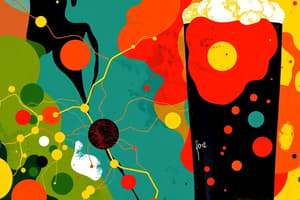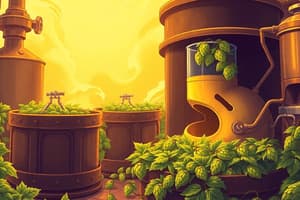Podcast
Questions and Answers
What are the primary ingredients used in beer making?
What are the primary ingredients used in beer making?
- Water, Barley, Hops, Corn
- Barley, Hops, Sugar, Yeast
- Water, Malt, Hops, Yeast (correct)
- Water, Sugar, Yeast, Flavoring
Fermentation in beer making occurs in the presence of oxygen.
Fermentation in beer making occurs in the presence of oxygen.
False (B)
What is the purpose of malting in the brewing process?
What is the purpose of malting in the brewing process?
To allow the grain to germinate and produce enzymes that break down starch into fermentable sugar.
In the fermentation process, pyruvate is converted to ________ before being turned into ethanol.
In the fermentation process, pyruvate is converted to ________ before being turned into ethanol.
Match the stages of the beer making process to their descriptions:
Match the stages of the beer making process to their descriptions:
What is the main difference between red wine and white wine production?
What is the main difference between red wine and white wine production?
The primary purpose of adding sulphur dioxide during fermentation is to enhance the flavor of the wine.
The primary purpose of adding sulphur dioxide during fermentation is to enhance the flavor of the wine.
What is the process called that causes lactic acid to be produced in wine, making it softer and adding flavor?
What is the process called that causes lactic acid to be produced in wine, making it softer and adding flavor?
The method of removing large complex polysaccharides during the clarification process is called __________.
The method of removing large complex polysaccharides during the clarification process is called __________.
Which of the following materials can be used for fining in the wine clarification process?
Which of the following materials can be used for fining in the wine clarification process?
Match the types of grape with their respective wine categories:
Match the types of grape with their respective wine categories:
What technique is used in champagne production to remove yeast after secondary fermentation?
What technique is used in champagne production to remove yeast after secondary fermentation?
Colored bottles are used in the bottling process to prevent photo-oxidation of white wine.
Colored bottles are used in the bottling process to prevent photo-oxidation of white wine.
What is the purpose of malting barley?
What is the purpose of malting barley?
β-amylase is functional at lower temperatures than α-amylase.
β-amylase is functional at lower temperatures than α-amylase.
What does the Standard Reference Method (SRM) measure?
What does the Standard Reference Method (SRM) measure?
The process of separating clear liquid wort from residual grain is called __________.
The process of separating clear liquid wort from residual grain is called __________.
Match the fermentation process with its type:
Match the fermentation process with its type:
Which temperature range is optimal for mashing the barley?
Which temperature range is optimal for mashing the barley?
Hops are added to beer primarily for their sweet flavor.
Hops are added to beer primarily for their sweet flavor.
What is the primary yeast species used in ale fermentation?
What is the primary yeast species used in ale fermentation?
The process used to recover sugar from the grains during lautering is called __________.
The process used to recover sugar from the grains during lautering is called __________.
Match the fermentation profile of beer with its characteristics:
Match the fermentation profile of beer with its characteristics:
What is used to estimate the alcohol content in beer?
What is used to estimate the alcohol content in beer?
Bottle conditioning involves adding sugar to create fizz in the beer.
Bottle conditioning involves adding sugar to create fizz in the beer.
What byproduct can yeast from the brewing process be utilized for?
What byproduct can yeast from the brewing process be utilized for?
In winemaking, the process of separating yeast from wine early is called __________.
In winemaking, the process of separating yeast from wine early is called __________.
What is the primary purpose of drying and kilning in the malting process?
What is the primary purpose of drying and kilning in the malting process?
Flashcards
Malting
Malting
The process of converting starch into fermentable sugars, such as maltose and glucose, using enzymes produced during the malting process.
Mashing
Mashing
The process of combining malted grains with hot water to extract fermentable sugars into a soluble suspension.
Hopping
Hopping
The process of adding hops to beer during brewing, providing flavor and stability.
Fermentation
Fermentation
Signup and view all the flashcards
Aging
Aging
Signup and view all the flashcards
What is the purpose of adding sulphur dioxide to wine must?
What is the purpose of adding sulphur dioxide to wine must?
Signup and view all the flashcards
What does Saccharomyces do during fermentation?
What does Saccharomyces do during fermentation?
Signup and view all the flashcards
What occurs during malolactic fermentation?
What occurs during malolactic fermentation?
Signup and view all the flashcards
What are some clarification methods used in winemaking?
What are some clarification methods used in winemaking?
Signup and view all the flashcards
What is the purpose of maturation in winemaking?
What is the purpose of maturation in winemaking?
Signup and view all the flashcards
What is blending in winemaking?
What is blending in winemaking?
Signup and view all the flashcards
Why are wine bottles often coloured?
Why are wine bottles often coloured?
Signup and view all the flashcards
What causes the fizz in champagne?
What causes the fizz in champagne?
Signup and view all the flashcards
Lautering
Lautering
Signup and view all the flashcards
Lovibond Scale
Lovibond Scale
Signup and view all the flashcards
Malolactic Fermentation
Malolactic Fermentation
Signup and view all the flashcards
Racking (wine)
Racking (wine)
Signup and view all the flashcards
α-amylase
α-amylase
Signup and view all the flashcards
β-amylase
β-amylase
Signup and view all the flashcards
Maltose
Maltose
Signup and view all the flashcards
Dextrin
Dextrin
Signup and view all the flashcards
Original Gravity (OG)
Original Gravity (OG)
Signup and view all the flashcards
Final Gravity (FG)
Final Gravity (FG)
Signup and view all the flashcards
Delta G
Delta G
Signup and view all the flashcards
Study Notes
Beer Production
- Beer production involves specific steps to ensure reproducibility
- Key ingredients are water, malt, hops, and yeast
- Alcohol fermentation is anaerobic, converting pyruvate to ethanol
- Malt is derived from seeds (barley, wheat, rye, rice)
- Malting involves steeping, germination, and drying which releases enzymes to break down starch into fermentable sugars (maltose, glucose)
- Kilning alters flavor and color via the Maillard reaction
- Standard Reference Method (SRM)/Lovibond scale grades malted barley color
- Mashing digests starch to fermentable sugars using enzymes (alpha-amylase, beta-amylase)
- Controlling temperature activates specific enzymes to target conversion of starch (45-65°C), allowing desired breakdown, not complete digestion.
- Lautering separates the wort (liquid) from the grains
- Sparging rinses the grains for sugar recovery.
- Hopping adds bitter flavor and stability (antimicrobial) to the sweet wort boiled for 1-2 hours
- Fermentation cools wort (12-18°C), adds yeast ( Saccharomyces cerevisiae or Saccharomyces carlsbergensis) to produce alcohol
- Ale is top-fermenting, lager is bottom-fermenting
- Measuring initial and final gravity (OG & FG) helps estimate alcohol content
- Downstream processing includes using yeast as animal feed or yeast extract, cask, keg, and bottle conditioning
- Beer has low nutrient levels, ethanol content, and low pH ( ~4.0) to inhibit microbial growth
Wine Production
- Wine production follows a generalized process
- Grapes are harvested, crushed, and must (wine wort) produced
- Sulphur dioxide controls unwanted microbes during fermentation
- Saccharomyces yeasts are added for fermentation
- Racking separates wine from sediment to ensure purity.
- Malolactic fermentation converts malic acid (not desired) to lactic acid (desired flavour)
- Aging conditions develop flavors and complex traits
- Wine can be blended, clarified by fining or filtration and further aged/matured
- Bottling is the final step, with color-related considerations (light and photo-oxidation) for flavor preservation.
- Special processes like those for Champagne involve secondary fermentation and riddling to achieve carbonation.
Studying That Suits You
Use AI to generate personalized quizzes and flashcards to suit your learning preferences.




